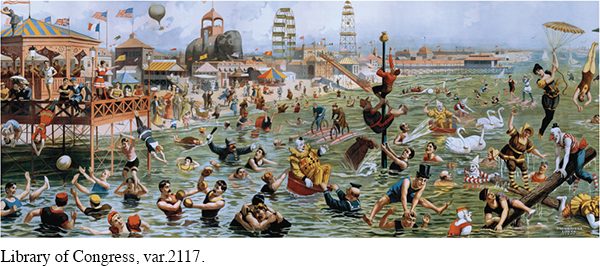Cheap Amusements
Growing class divisions manifested themselves in patterns of leisure as well as in work and home life. The poor and working class took their leisure, when they had any, not in the crowded tenements that housed their families but increasingly in the cities’ new dance halls, music houses, ballparks, and amusement arcades, which by the 1890s formed a familiar part of the urban landscape[[LP Photo: P19.07 Beach Scene at Coney Island/

> ANALYZE EVIDENCE
What does the emergence of the practice of “treating” suggest about the ways and the degree to which urban industrialism transformed customs related to interactions between young women and young men?
Young workingwomen no longer met prospective husbands only through their families. Fleeing crowded tenements, the young sought each other’s company in dance halls and other commercial retreats. Young workingwomen counted on being “treated” by men, a transaction that often implied sexual payback. Their behavior sometimes blurred the line between respectability and promiscuity. The dance halls became a favorite target of reformers who feared they lured teenage girls into prostitution.
For men, baseball became a national pastime in the 1870s—then, as now, one force in urban life capable of uniting a city across class lines. Cincinnati mounted the first entirely paid team, the Red Stockings, in 1869. Soon professional teams proliferated in cities across the nation, and Mark Twain hailed baseball as “the very symbol, the outward and visible expression, of the drive and push and rush and struggle of the raging, tearing, booming nineteenth century.”
The increasing commercialization of entertainment in the late-nineteenth-century city was best seen at Coney Island. A two-mile stretch of sand nine miles from Manhattan by trolley or steamship, Coney Island in the 1890s was transformed into the site of some of the largest and most elaborate amusement parks in the country. Promoter George Tilyou built Steeplechase Park in 1897, advertising “10 hours of fun for 10 cents.” With its mechanical thrills and fun-house laughs, the amusement park encouraged behavior that one schoolteacher aptly described as “everyone with the brakes off.” By 1900, as many as a million New Yorkers flocked to Coney Island on any given weekend, making the amusement park the unofficial capital of a new mass culture.
> QUICK REVIEW
How and why did recreation and leisure change in the last decades of the nineteenth century?
Understanding the American Promise 3ePrinted Page 547